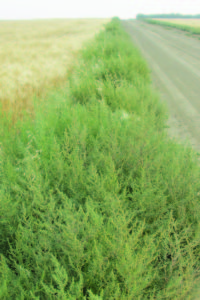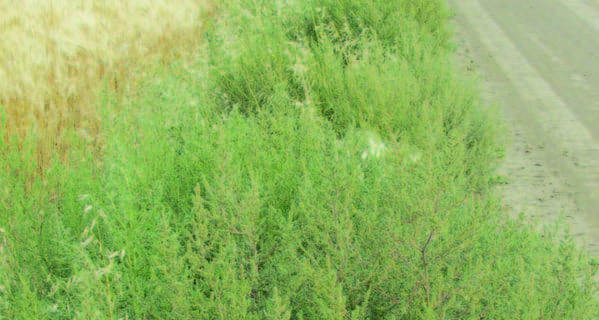By T. Martin-Schmunk
of The Crossroads
Kochia, a familiar weed, has become more than a nuisance in many areas across the Prairies.
Kochia scoparia is designated a noxious weed (defined as harmful or injurious to agricultural crops) in Saskatchewan in accordance with The Weed Control Act, dated Dec. 1, 2010.

Mature kochia along a roadside.
Native to Asia and parts of Europe, the weed was brought to Canada by European settlers as an ornamental plant; it was also useful as a forage plant for livestock producers.
[emember_protected for=”2″ custom_msg=’For more on this story, please see this week’s print edition of The Cross Roads.’]
According to a Weed of the Week report (June 11, 2015) by Michael Raine of The Western Producer, kochia is one of the more damaging weeds. Kochia has the ability to produce up to 25,000 seeds per plant if it reaches maturity. As a tumbleweed, it has one of the most effective seed spreading systems. It is capable of growing up to two metres in height when competing with tall crops.
The seeds are among the earliest to emerge in the spring, taking one – three days to germinate. It is often quite advanced when other broadleaf weeds are ready to spray. Additional flushes of germination can occur throughout the growing season.
Raine stated, “Kochia has the ability to generate the right mutations to form the basis for herbicide tolerance selection.” There is data to support that kochia is glyphosate-resistant, as well as being resistant to Group 2 herbicides. Field experience would indicate that Groups 4 and 6 are not highly effective either. It is estimated that it costs a farmer an extra $10 – $20 per acre to fight resistant weeds.
It has been evident in my travels this summer, in all directions (Eatonia, Kindersley, Saskatoon; Mantario, Oyen, Calgary; Mendham, Burstall, Medicine Hat; Swift Current, Regina) that kochia is a widespread problem. It can be found along roadsides, in ditches, sloughs, field edges, around bins, along the rail line and surrounding gas wells. Not to mention fields where it has overtaken crops. It is within numerous towns and as I write this, there are even kochia weeds on our news office lot.
Understanding the nature of the beast is key to fighting the problem. According to gov.mb.ca/agriculture, kochia is tolerant of drought and saline soils; it thrives under growing conditions considered poor for most crops. It quickly invades and establishes itself on saline spots within fields. During drought conditions kochia roots can extend as far as 10 feet or more in the soil in search of moisture and nutrients, explaining its predominance during dry years.
Raine noted that “just 21 plants per square metre reduce wheat yields by one-third.” Gov.mb.ca/agriculture noted that “195 plants per square metre have reduced wheat yields by 73 per cent.”
Raine also reported, “In flax and pulse crops, the plant can be devastating.”
The question that needs to be asked — who is responsible for battling this noxious weed? Landowners stand to lose the most but it is clear that responsibility lies not only with individuals, but with businesses and local government organizations as well.
The majority of rural municipalities in Saskatchewan have appointed weed inspectors. Saskatchewan.ca states that the weed inspector’s role under The Weed Control Act “is to monitor the municipality for prohibited and noxious weeds to detect new occurrences of those weeds in a timely manner. The weed inspector must also respond to complaints from residents of the municipality regarding prohibited, noxious and nuisance weeds. The weed inspector’s secondary role is to coordinate overall invasive weed management in a municipality.” More specific information can be found on the website.
Given the nature of this particular weed, it is clear that a joint effort is necessary to control and contain the kochia population within a region.
The Manitoba government website (gov.mb.ca/agriculture) suggests the following points to consider when developing a kochia management strategy.
- Pay attention to pre-seeding weed control.
- Spray early. Most herbicides only control kochia when it is very small.
- Watch out for herbicide resistance.
- Prevent seed production. Kochia seeds are short-lived, therefore preventing seed production will decrease the next year’s infestation. A good herbicide program combined with patch mowing or spraying, and cutting areas for feed are effective ways of preventing seed production.
At this time of year, mowing of roadsides, ditches, field edges and polluted areas in fields is necessary; spot-tillage may be called for as well.
Crop rotation is a key factor in weed management. An option to consider is to seed infested land with a forage crop.
Action based on knowledge is key to effective control of kochia.

